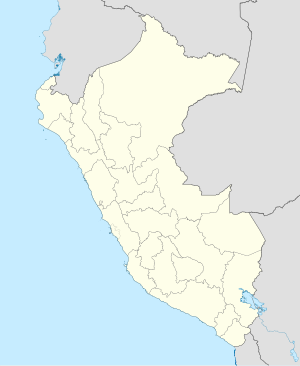Verrugas Bridge
Coordinates: 11 ° 53 ′ 22 ″ S , 76 ° 29 ′ 15 ″ W.
| Verrugas Bridge - Puente Carrión | ||
|---|---|---|
| use | Railway bridge | |
| Crossing of | Rio Carrión | |
| place | San Bartolome - San Jeronimo de Surco | |
| construction | Truss bridge | |
| overall length | 218 m | |
| Clear height | approx. 80 m | |
| completion | 1873/1890/1937 | |
| location | ||
|
|
||
The Verrugas Bridge ( Spanish : Viaducto de Verrugas or, more commonly today, Puente Carrión ) in Peru is the largest railway bridge on the Ferrocarril Central Andino route from Lima through the Río Rímac valley to La Oroya and on to Huancayo .
It stands between the towns of San Bartolome and San Jeronimo de Surco at km 84.4 at an altitude of 1800 m above sea level. M. and leads the railway track high on the slope over a steep and deeply cut mountain stream.
The steel truss bridge is 218 m long including a short ramp. It is supported by two half-timbered pillars that stand on large concrete plinths on the slopes of the stream bed. It consists of 22 compartments, which are not covered, so that between and next to the tracks you can look into the depths. There is a pedestrian walkway at the edge of the bridge.
The first, wrought-iron bridge was built as part of the construction of the route that the American Henry Meiggs had agreed with the Peruvian government in 1869. It was planned by the Baltimore Bridge Company with Fink girders , built under their local site manager Leffert L. Buck and commissioned in January 1873. At that time it was one of the largest wrought iron bridges in the world.
When the construction of the railway line left the coastal region and arrived in locations over 1000 m, the workers who lived under the worst hygienic conditions developed a completely new disease. The workers first suffered from a high fever before many died of severe anemia (anemia) and secondary infections such as miliary tuberculosis , shigellosis and salmonellosis . This disease was later described as Oroya fever , in the late stages of which warts known as Verruga peruana develop. The connection between the fever and the warts was proven by the fatal self-experiment of the Peruvian medical student Daniel Alcides Carrión (1857–1885), after whom the disease and (among other buildings) the bridge were later named.
In March 1889, the bridge was destroyed by the raging mountain stream and a landslide. The second bridge was planned by Leffert L. Buck as a cantilever bridge and completed at the end of 1890 after a six-month construction period.
The third, today's bridge, was necessary to replace the older bridge, as it could no longer cope with the increased traffic loads. It was in 1937 by Cleveland Bridge & Engineering Co. built.
Web links
- Centenario de la Inauguración de la Estación de Desamparados (1912 - 2012) (PDF; 1.4 MB) Representation of the route with a description of the Puente Carrión.
- Kirti Gandhi: Verrugas Viaduct and its reconstruction, Peru, South America . In: Khaled M. Mahmoud (Ed.): Safety and reliability of bridge structures. Chapter 42, CRC Press 2009, ISBN 978-0-415-56484-7 .
Individual evidence
- ↑ So in Centenario de la Inauguración de la Estación de Desamparados. In other descriptions the length is given as 175 m = 574.15 ft. The 22 compartments can be clearly seen on photos and in Google Earth, the length of the trusses is approx. 200 m in total. Both the American and the later English planners and bridge builders calculated in feet and usually chose round numbers for the large dimensions of a building. If you divide the 175 m = 574 ft by 22, the length per compartment is 26.09 ft, which is an unlikely measure. If, on the other hand, one assumes the length of a compartment to be 30 ft, the total length is 660 ft (201.16 m). In addition, there is the short connecting bridge at the end of the valley, which is nowhere specifically mentioned but clearly recognizable in photos, so that the specified length of 218 m is correct, but the otherwise mentioned length of 175 m should be that of the older bridge.
- ↑ The Verrugas Viaduct. In: Engineering. Vol. 13, April 12, 1872, pp. 247-249.
- ↑ Top 10 Researchers who Experimented on Themselves


